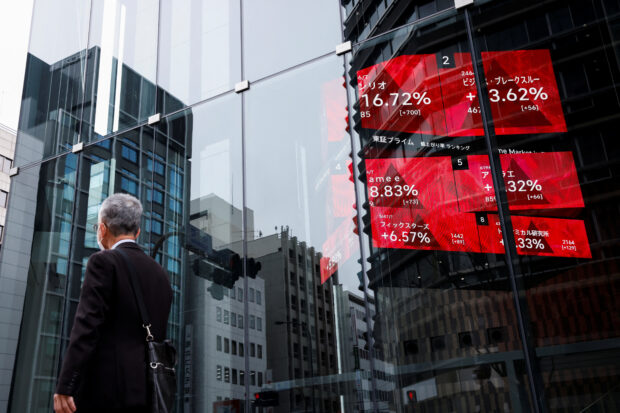
A man walks past an electronic board showing stock visualizations outside a brokerage, in Tokyo, Japan, March 17, 2023. REUTERS/Androniki Christodoulou
SYDNEY — Asian shares dithered on Monday as investors worried U.S. inflation data this week could derail the outlook for lower interest rates, while the risk of currency intervention from Japan stalled the yen’s decline for the moment.
China’s central bank also engineered a rally in the yuan after setting a firmer fix for the currency, nudging the dollar lower more broadly.
The main data event of the week will be U.S. core personal consumption expenditure (PCE) price index on Friday which is seen rising 0.3 percent in February, keeping the annual pace at 2.8 percent . Anything higher would be taken as a setback to hopes for a Federal Reserve rate cut in June.
Many markets are closed for Easter on Friday, when the PCE data is due for release, so the full reaction will have to wait until next week.
Fed Chair Jerome Powell was sufficiently dovish last week to leave futures implying around a 74-percent chance of a June easing, up from 55 percent a week earlier.
READ: Fed seen on hold until June, with rate-cut pace in focus
Powell will participate in a moderated discussion at a policy conference on Friday, while Fed governors Lisa Cook and Christopher Waller are also appearing this week.
Europe’s own inflation tests
Europe has its own inflation tests with consumer price data out from France, Italy, Belgium and Spain, ahead of the overall EU CPI report on April 3.
Sweden’s central bank meets on Wednesday and is generally expected to keep rates at 4 percent , though a surprise easing by the Swiss National Bank (SNB) last week has markets anticipating a dovish statement.
Expectations for falling borrowing costs globally has been a boon for equities, with the S&P 500 up almost 10 percent for the year to date. Early Monday, S&P 500 futures and Nasdaq futures were trading little changed.
MSCI’s broadest index of Asia-Pacific shares outside Japan edged up 0.1 percent, to just below eight-month highs.
Japan’s Nikkei dipped 0.4 percent, having spiked 5.6 percent last week to a fresh all-time peak as the yen weakened.
READ: Japan stocks rise, yen slips to 150 after BOJ decision
While the Fed sounded dovish last week, it was hardly alone, with the Swiss central bank (SNB) actually cutting rates while the Bank of England (BoE) and European Central Bank (ECB) left markets looking for easing from June onwards.
The People’s Bank of China (PBOC) also surprised markets on Friday by letting the yuan fall past 7.2 per dollar to four-month lows amid talk it was set to ease policy further.
Japan jawbones the yen
“We think the dollar’s rebound reflects the more explicitly dovish stance of other major central banks – in particular the SNB and the BoE,” said Jonas Goltermann, deputy chief markets economist at Capital Economics.
“The PBOC’s apparent decision to let the renminbi weaken sharply has added to the overall dollar-positive tone,” he added. “Overall, the greenback heads into the Easter holiday period firmly on the front foot, and continued solid U.S. economic data is likely to keep it that way.”
Even a shift away from super-easy policies by the Bank of Japan (BOJ) could not dent the dollar, as investors assumed it was not the start of a series of hikes and futures imply a rate of just 20 basis points by year end.
READ: Bank of Japan ends negative rates, closing era of radical policy
On Monday, the dollar was holding at 151.30 yen, having climbed 1.6 percent last week to a peak of 151.86. Markets are wary of testing 152.00 as that is a level that has drawn Japanese intervention in the past.
Indeed, Japan’s top currency official on Monday warned the yen’s current weakness did not reflect fundamentals and excessive moves were unwelcome.
The euro was pinned at $1.0808, having been dragged down in the wake of the Swiss franc after the SNB’s shock rate cut.
The strength of the dollar took some shine off gold which stood at $2,168 an ounce, after hitting a record peak of $2,217.79 last week.
Oil prices were underpinned by Ukraine’s attacks on Russian refineries, along with data showing a fall in U.S. rig counts.
Brent rose 21 cents to $85.64 a barrel, while U.S. crude edged up 23 cents to $80.86 per barrel.

